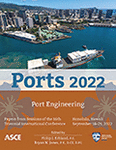Multi-Scale Numerical Simulation of Tsunami-Driven Debris-Field Impacts
Publication: Ports 2022
ABSTRACT
In current practice, debris-field impact loading for near-water structures is usually derived from (1) infrequent case histories, (2) simplified analytical equations, and (3) practitioner experience. Via advanced numerical simulation of tsunami-driven debris-field impacts at multiple scales and conditions, we are now forging a modeling approach to address a wider range of scenarios. Broadened cases are characterized, with chaotic natures expressed stochastically. The analytical tools have the potential to strengthen the basis of ASCE 7 guidelines and to encompass events not yet described in the code.
Get full access to this article
View all available purchase options and get full access to this chapter.
REFERENCES
Nistor, I., Goseberg, N., and Stolle, J. (2017). Tsunami-driven debris motion and loads: A critical review. Frontiers in Built Environment, 3, 2.
Shekhar, K., Winter, A. O., Alam, M. S., Arduino, P., Miller, G. R., Motley, M. R., Eberhard, M. O., Barbosa, A. R., Lomonaco, P., and Cox, D. T. (2020). Conceptual Evaluation of Tsunami Debris Field Damming and Impact Forces. Journal of Waterway, Port, Coastal, and Ocean Engineering, 146(6), 04020039.
Naito, C., Cercone, C., Riggs, H. R., and Cox, D. (2014). Procedure for Site Assessment of the Potential for Tsunami Debris Impact. Journal of Waterway, Port, Coastal, and Ocean Engineering, 140(2), 223–232.
Jiang, C., Schroeder, C., Selle, A., Teran, J., and Stomakhin, A. (2015). The affine Particle-In-Cell method. ACM Transactions on Graphics, 34(4), 1–10.
Chock, G. Y. K. (2016). The ASCE 7 Tsunami Loads and Effects Design Standard for the U.S.
Mast, C., Mackenzie-Helnwein, P., Arduino, P., Miller, G., and Shin, W. (2012). Mitigating kinematic locking in the Material Point Method, Journal of Computational Physics, Vol. 231, Issue 16, June 2012, pp. 5351–5373.
Vittoz, L., Oger, G., de Leffe, M., and le Touzé, D. (2019). Comparisons of weakly-compressible and truly incompressible approaches for viscous flow into a high-order Cartesian-grid finite volume framework. Journal of Computational Physics: X, 1, 100015.
Fei, Y., Huang, L., Guo, Q., Wu, R., and Gao, M. (2021). Revisiting Integration in the Material Point Method: A Scheme for Easier Separation and Less Dissipation. ACM Trans. Graph, 40, 16.
Zhang, F., Zhang, X., Yim Sze, K., Lian, Y., and Liu, Y. (2017). Incompressible material point method for free surface flow. Journal of Computational Physics, 330, 92–110.
Wang, X., Qiu, Y., Slattery, S. R., Fang, Y., Li, M., Zhu, S.-C., Zhu, Y., Tang, M., Manocha, D., and Jiang, C. (2020). Article 30. 2020. A Massively Parallel and Scalable Multi-GPU Material Point Method. ACM Trans. Graph, 39(4), 15.
Lomonaco, P., Alam, M. S., Arduino, P., Barbosa, A., Cox, D. T., Do, T., Eberhard, M., Motley, M., Shekhar, K., Tomiczek, T., Park, H., van de Lindt, J. W., and Winter, A. (2018). Experimental modeling of wave forces and hydrodynamics on elevated coastal structures subject to waves, surge or tsunamis: the effect of breaking, shielding and debris. Coastal Engineering Proceedings, 36, 53–53.
Moehle, J., and Deierlein, G. G. (2004). A Framework Methodology for Performance-Based Earthquake Engineering.
Attary, N., van de Lindt, J. W., Barbosa, A. R., Cox, D. T., and Unnikrishnan, V. U. (2019). Performance-Based Tsunami Engineering for Risk Assessment of Structures Subjected to Multi-Hazards: Tsunami following Earthquake. 25(10), 2065–2084.
Sulsky, D., Chen, Z., and Schreyer, H. L. (1993). A particle method for history-dependent materials.
Tran, Q. A., and Sołowski, W. (2019). Temporal and null-space filter for the material point method. International Journal for Numerical Methods in Engineering, 120(3), 328–360.
Hammerquist, C. C., and Nairn, J. A. (2017). A New Method for Material Point Method Particle Updates that Reduces Noise and Enhances Stability.
Brackbill, J. U., and Ruppel, H. M. (1986). FLIP: A method for adaptively zoned, particle-in-cell calculations of fluid flows in two dimensions. Journal of Computational Physics, 65(2), 314–343.
Tampubolon, A. P., Teran, J., Gast, T., Klár, G., Fu, C., Jiang, C., and Museth, K. (2017). Multi-species simulation of porous sand and water mixtures. ACM Trans. Graph, 36.
Yang, W., Arduino, P., Miller, G. R., and Mackenzie-Helnwein, P. (2018). Smoothing algorithm for stabilization of the material point method for fluid–solid interaction problems. Computer Methods in Applied Mechanics and Engineering.
Piran Aghl, P., Naito, C. J., and Riggs, H. R. (2014). Investigating the Effect of Nonstructural Mass on Impact Forces from Elastic Debris. Structures Congress 2014 - Proceedings of the 2014 Structures Congress, 635–644.
de Vaucorbeil, A., Nguyen, V. P., and Hutchinson, C. R. (2020). A Total-Lagrangian Material Point Method for solid mechanics problems involving large deformations. Computer Methods in Applied Mechanics and Engineering, 360, 112783.
Hasanpour, A., Istrati, D., and Buckle, I. (2021). Coupled SPH–FEM Modeling of Tsunami-Borne Large Debris Flow and Impact on Coastal Structures. Journal of Marine Science and Engineering 2021, Vol. 9, Page 1068, 9(10), 1068.
Irving, G., Teran, J., and Fedkiw, R. (2004). Invertible Finite Elements For Robust Simulation of Large Deformation.
Fu, C., Guo, Q., Gast, T., Jiang, C., and Teran, J. (2017). A polynomial particle-in-cell method. ACM Transactions on Graphics, 36 (6).
Information & Authors
Information
Published In
History
Published online: Sep 15, 2022
Authors
Metrics & Citations
Metrics
Citations
Download citation
If you have the appropriate software installed, you can download article citation data to the citation manager of your choice. Simply select your manager software from the list below and click Download.
